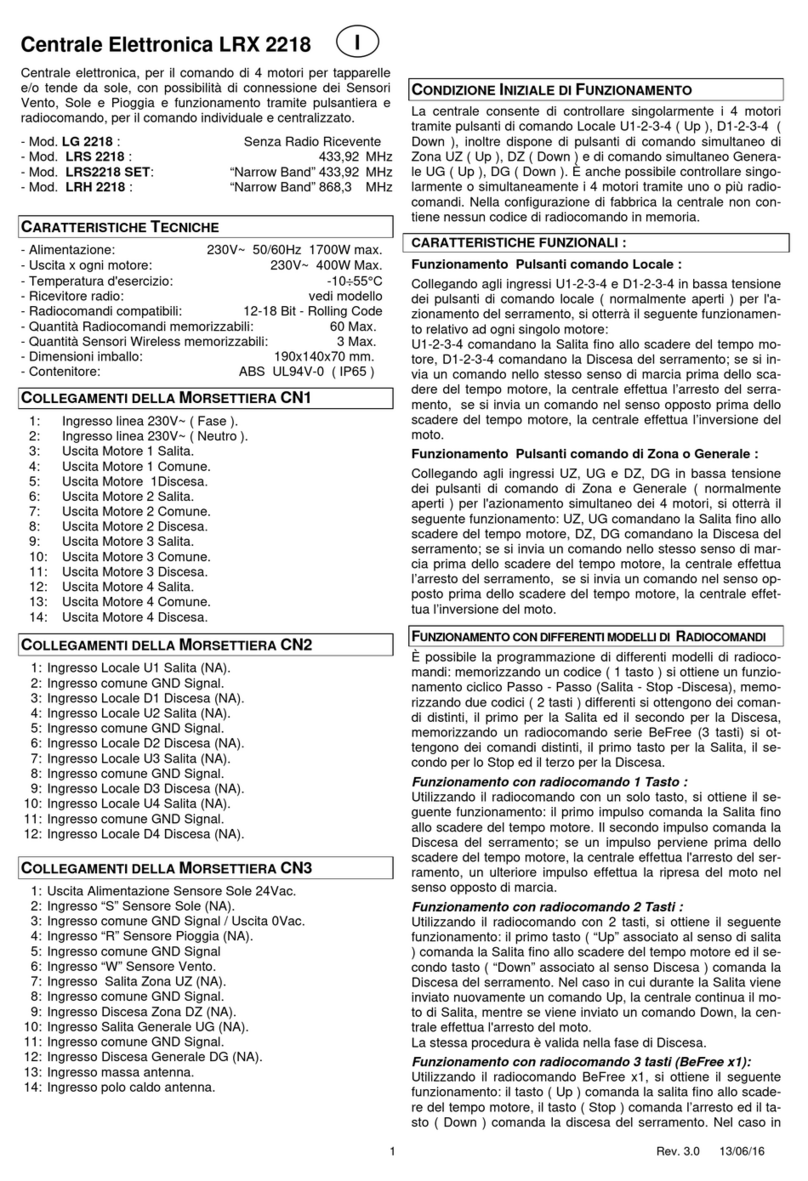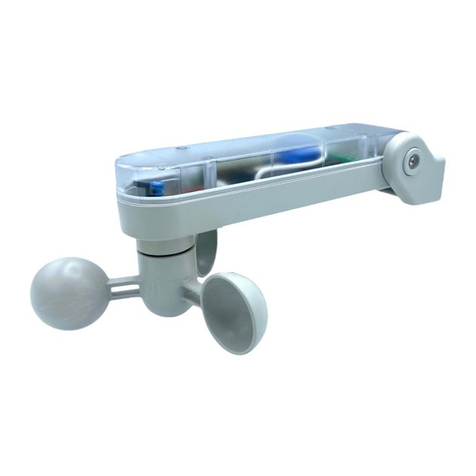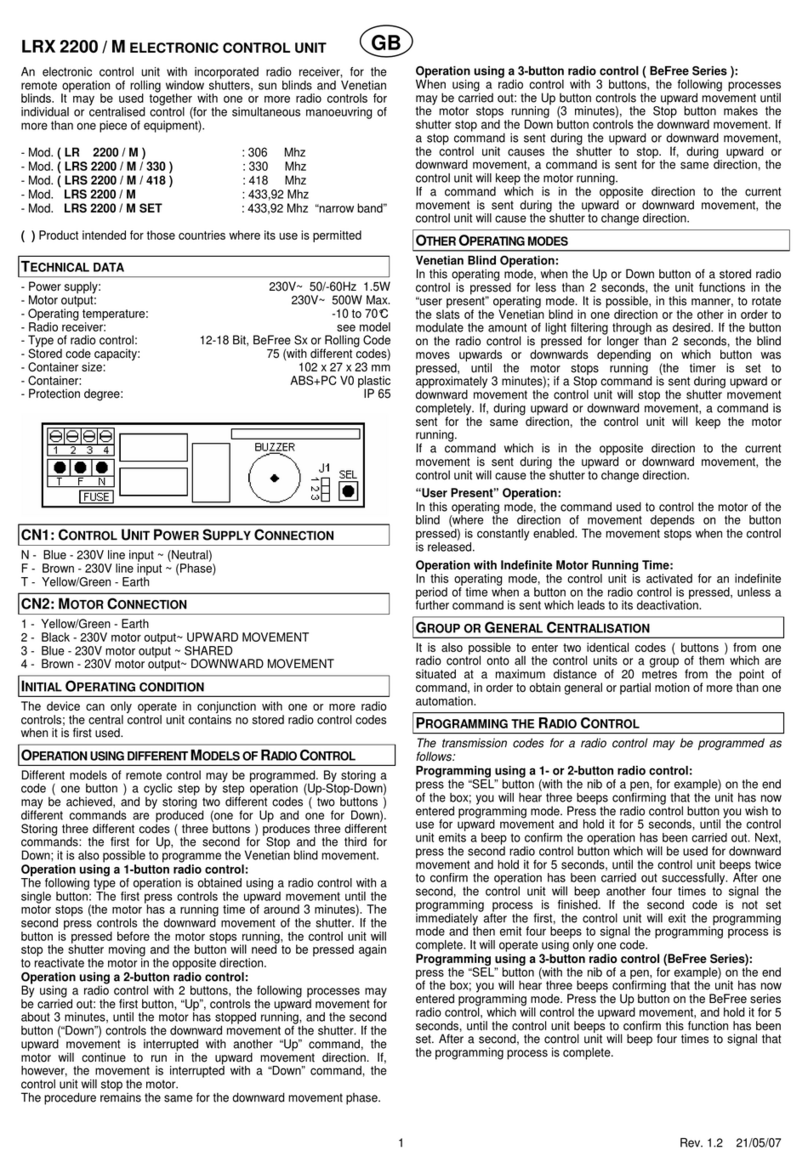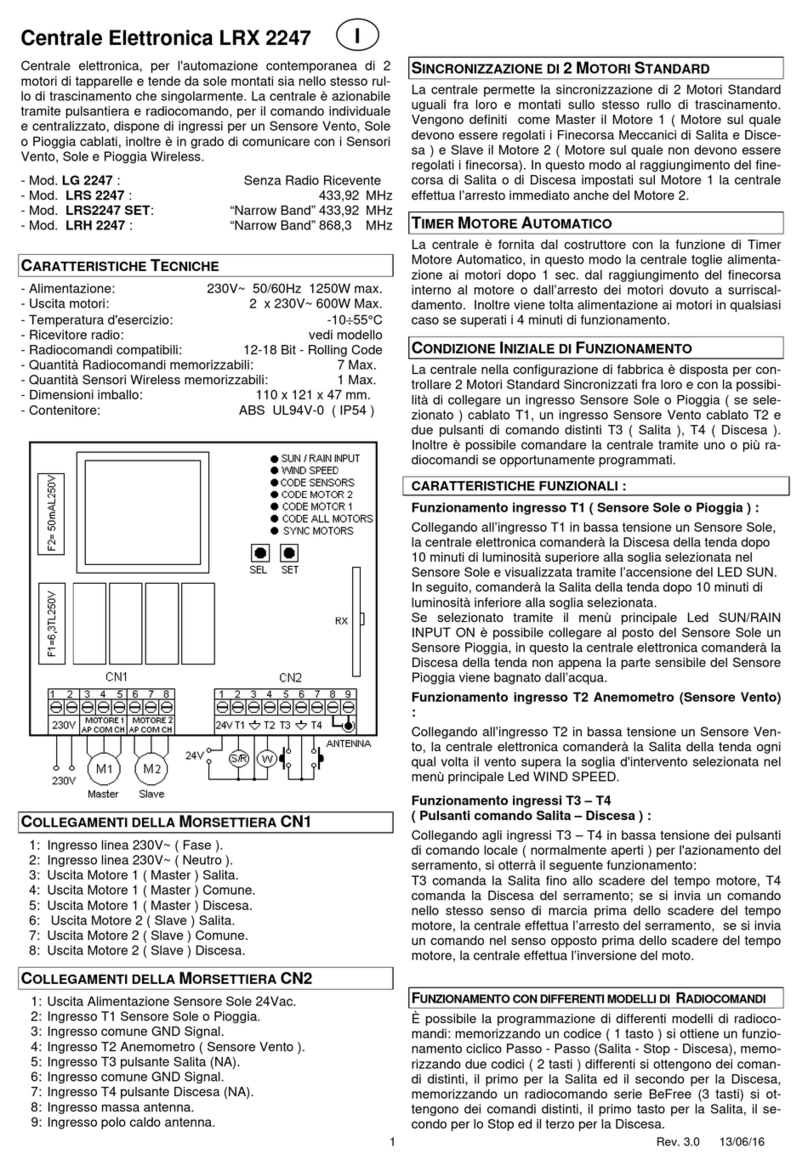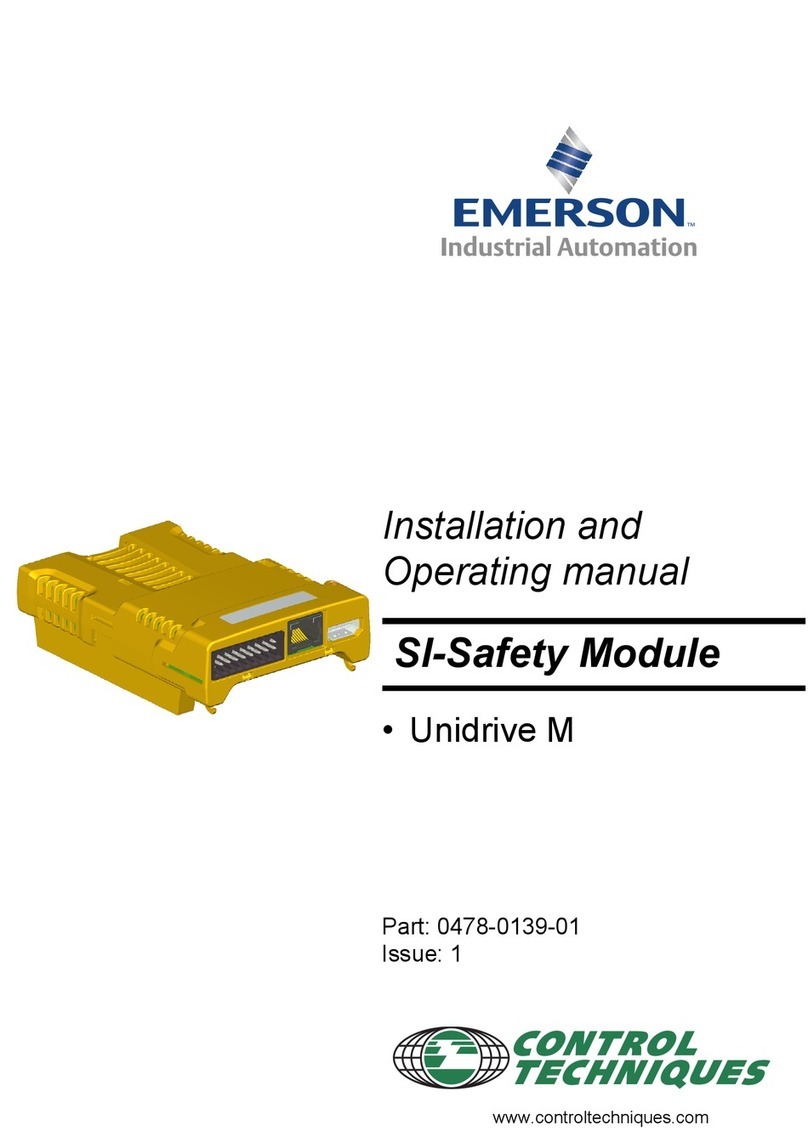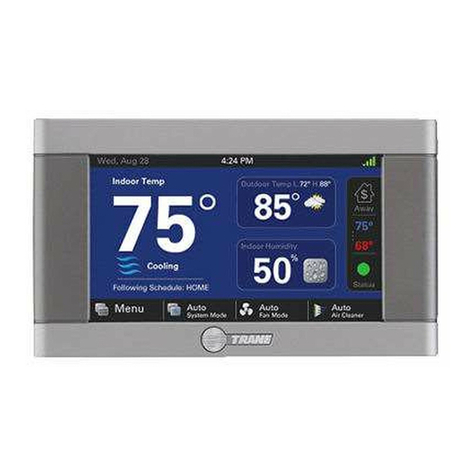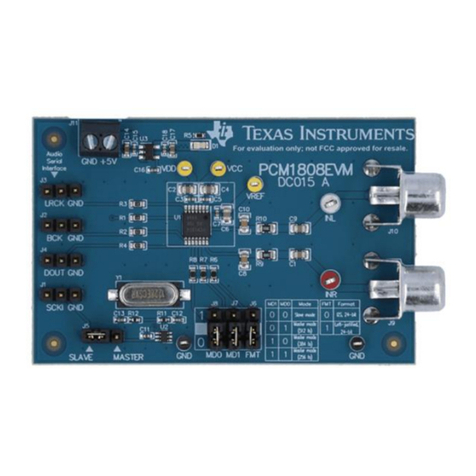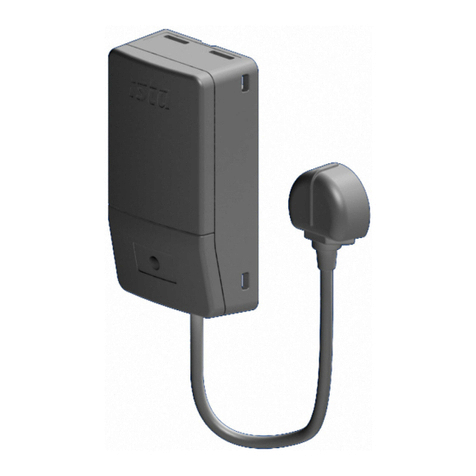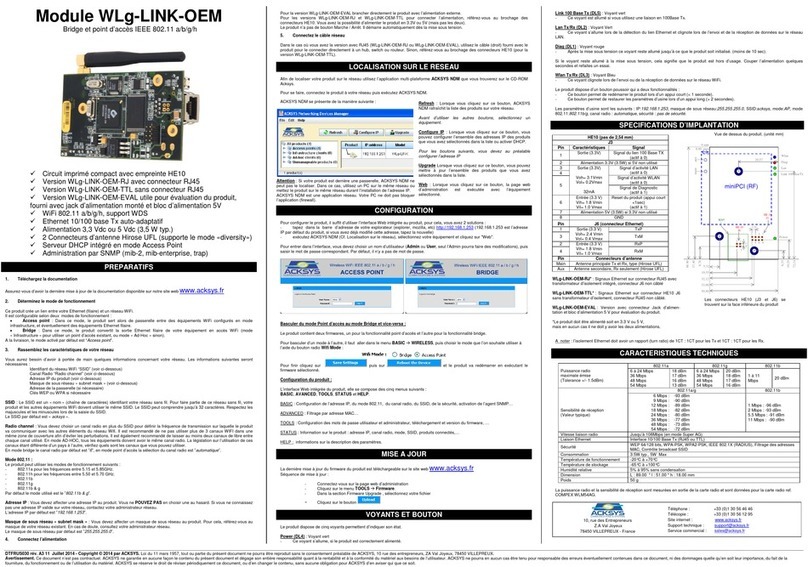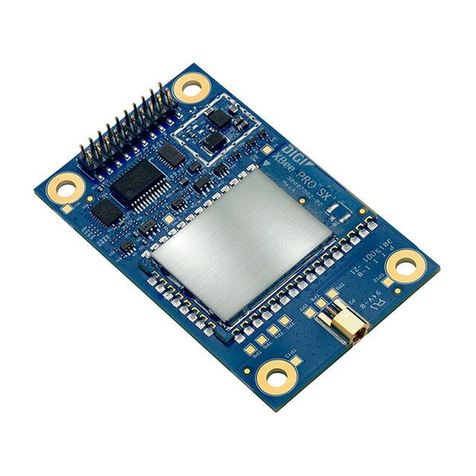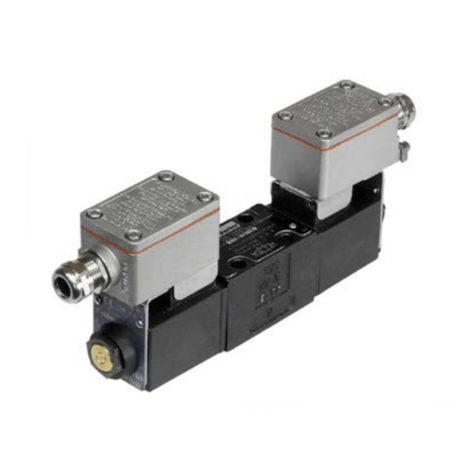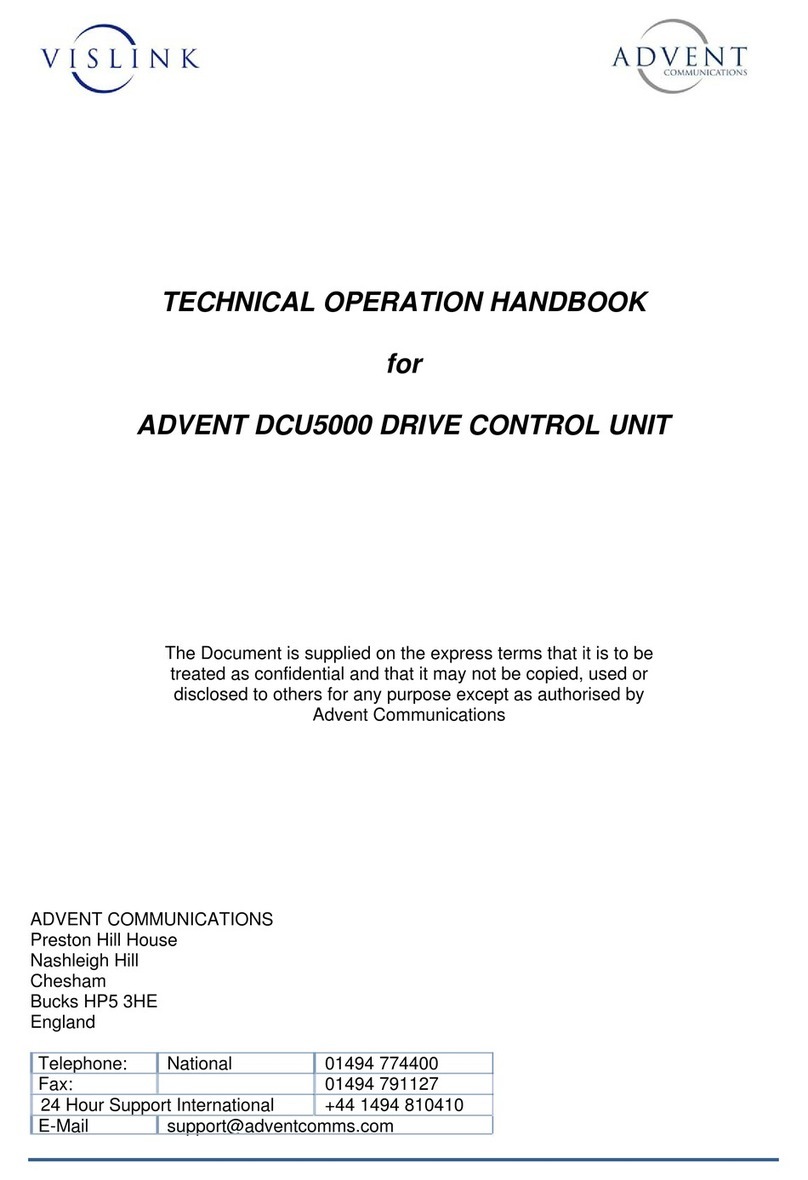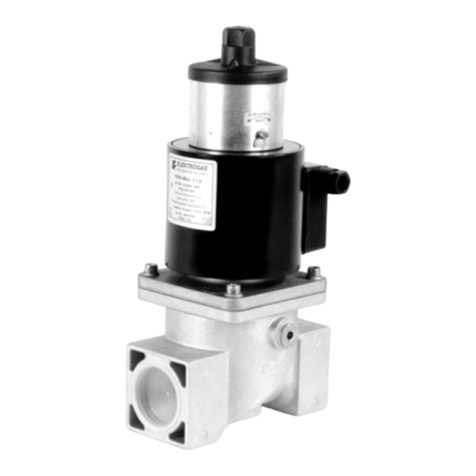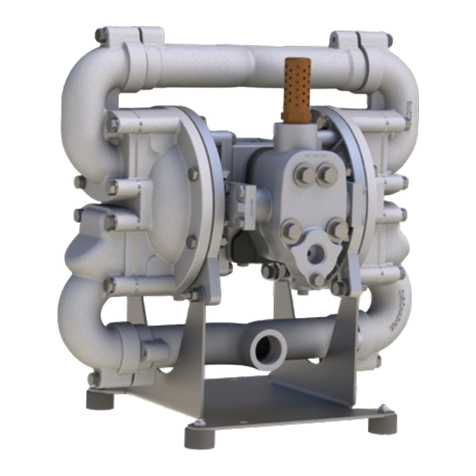Seav LG 2060 New Reader User manual

1 rev. 3.0 13/06/2016
ELECTRONIC PANEL
LRX 2060 NEW READER
Single-phase electronic control unit for the automation of
sliding gates, doors and barriers with incorporated radio
receiver for the implementation of commands given via Radio
control, Transponder, Digital keyboard and Smartphone.
The following can be connected to the control unit via BUS RS-
48:
- up to 2 BeSafe Readers New
- up to 2 BeSafe KEYBOARD selectors
- up to 2 BeSafe NFC Readers
- Mod. LG 2060 New Reader : Without radio receiver
- Mod. LRS 2060 New Reader : 433.92 Mhz
- Mod. LRS 2060 New SET Reader : 433.92 Mhz narrow band
- Mod. LRH 2060 New Reader : 868.30 Mhz narrow band
I
MPORTANT FOR THE USER
- The device can be used by children over 8 years of age
and persons with reduced physical or psychological
abilities or with little knowledge and experience only if
supervised or educated in its operation and safe use, in
order to also understand the dangers involved in its use.
- these instructions are also available at the website
www.seav.com
- Do not allow children to play with the device and keep
the radio controls away from their reach.
- Frequently examine the system to detect any signs of
damage. Do not use the device if it is in need of repair
work.
-Always remember to disconnect the power supply before
carrying out any cleaning or maintenance.
- Cleaning and maintenance must not be carried out by
unsupervised children
- ATTENTION: keep this instruction manual safe and
observe the important safety requirements contained
herein. Failure to comply with the requirements may
cause damage and serious accidents.
I
MPORTANT FOR
the
INSTALLER
1) Before automating the frame, check that it is in good
condition, in compliance with the Machinery Directive
and with EN 12604.
2) Check that the location where the installation is
located enables compliance with operating temperature
limits specified for the device.
3) The safety of the final installation and compliance with
all prescribed Standards (EN 12453 - EN 12445) is the
responsibility of the person who assembles the various
parts to construct a total closing.
4) Use safety devices capable of monitoring the status
of their connection to the electrical control unit.
5) Once installation is finished, it is recommended that
all necessary checks be performed (appropriate
programming of the control panel and correct installation
of safety devices) to ensure that compliant installation
has been performed.
6) Fix the control unit to a wall, using the relevant
support which is fitted to the casing, in such a way as to
leave said support facing downwards and insert the fixing
screws in the special holes.
7) The control unit does not have any type of isolating
device for the 230 Vac line. It is therefore the
responsibility of the installer to set up an isolating device
inside the system. It is necessary to install an omnipolar
switch, surge category III. It must be positioned to
provide protection from accidental closing, pursuant to
point 5.2.9 of EN 12453.
8) Cables for power and connection to the motor
suitable for insertion in the pg9 cable glands provided
must have an outside diameter between 4.5 and 7 mm.
The internal conductors wires must have a nominal
section of 0.75mm2. If a raceway is not used, use
H05RR-F cables. Pay careful attention when fastening
the cables so that they are anchored in a stable manner.
Furthermore, care is required when drilling holes in the
outside casing where connecting and power supply
cables will pass, and when assembling the cable glands,
so that everything is installed so as to maintain the
panel's IP protection characteristics.
9) The gear motor used to move the frame must comply
with the requirements of point 5.2.7 of EN 12453.
10) In compliance with 5.4.2 of EN 12453, it is
recommended to use gear motors equipped with an
electrical-mechanical release device, so that the frame
can be moved manually in case of necessity.
11)
In compliance with 5.4.3. of EN 12453, use electrical-
mechanical release systems or similar devices which stop the
frame safely in the end run position.
12) The various electrical components external to the
control unit must be cabled in accordance with standard
EN 60204-1 as amended, and as set forth in point 5.2.7
of EN 12453. The power and connection cables must be
secured through the use of cable glands supplied.
13) The assembly of a push button panel for manual
control must be completed positioning the push button
panel in such a way that the user is not placed in a
dangerous position.
14) The safety function ensured by the control unit is
active only during closing, therefore, protection on
opening must be ensured in the installation phase with
measures (guards or safety distances) independent of
the control circuit.
15) For proper functioning of the radio receiver, if using
one or more control units, the installation at a minimum
distance of at least 3 metres one from the other is
recommended.
The electronic control unit:
LG
2060 New Reader
- LRS
2060 New Reader
LRS
2060 New SET Reader
- LRH
2060 New Reader
they comply with the specifications of the Directives
RED 2014/53/EU, EMC 2014/30/EU, LVD 2014/35/EU.
GB

2 rev. 3.0 13/06/2016
TECHNICAL DATA:
- Power supply : 230 Vac 50-60Hz 900W (4A) max.
- Flashing light output : 230 Vac 50-60 Hz
100W Resistive Load max.
50W Inductive Load max.
- Motor output : 230 Vac 50-60Hz 750 W max.
- Services power supply output : 24 Vac 3 W max.
- Safety devices and controls in BT: 24 Vdc
- Operating temperature : -10 ÷55 °C
- Radio receiver : 433.92 Mhz “narrow band”
- Op. transmitters : 12-18 Bit or Rolling Code
- No. of devices that can be stored : 120 max.
- Board dimensions : 100x105 mm.
- Dimensions of container : 110x121x47 mm.
- Container: ABS V-0 ( IP54 ).
TERMINAL BOARD CONNECTIONS:
CN1 :
1 : 230 Vac line input (Phase).
2 : 230 Vac line input (Neutral)
3 : 230 Vac Flashing light Output (Neutral).
4 : 230 Vac Flashing light Output (Phase).
5 : Opening 230V Motor Output.
6 : Common 230V Motor Output.
7 : Closing 230V Motor Output.
CN2:
1 :
Motor Opening Limit Switch Input (NC).
2 : Common GND input.
3 : Motor Closing Limit Switch Input (NC).
4 : Power supply to photocells ( 24Vac 3W).
5 : Power supply to photocells (GND).
6 : Control button input (NA).
7 : Common GND input
8 : Safety device input (NC).
9 : Aerial earth input.
10 : Aerial hot pole input.
CN3 :
1 : Power supply output 12 VDC Device.
2 : Communication port RS 485 signal A.
3 : Communication port RS 485 signal B.
4 : Power supply output 0 VDC Device.
OPERATING FEATURES:
Step-by-step operation:
By using either the Radio Control, Transponder, Digital
keyboard, Smartphone or the low voltage buttons to activate
the frame, you obtain the following action:
the first impulse activates the opening mechanism until the
motor time expires or the opening limit switch is reached, the
second impulse closes the gate. If an impulse is sent before
the motor time expires or one of the two end runs are reached,
the control unit will stop both opening and closing movements.
An additional control re-starts motion in the opposite direction.
Operating Mode using Radio Control,
Transponder, Digital keyboard and Smartphone:
The receiver can be combined with Radio Controls,
Transponders, Digital Keyboards, Smartphones and stores up
to 120 different users.
For use with radio controls, the receiver unit is equipped with
an incorporated receiver; for use of the other devices, the
desired accessory must be connected (by carefully following
the connection diagrams described in the relative operating
manuals) supplied as optionals.
Operation with different radio control models:
Different radio control models can be programmed: store one
code (1 key) for Step-by-Step cyclic operation (Opening - Stop -
Closing); store two different codes (2 keys) for
separate controls, the first for Opening and the second for
Closing; store one code (3 "BeFree series" keys) for three
separate controls, the first for
Opening, the second for Stop and the third for Closing.
Radio control operation with 1 Key:
Using the radio control with only one key, the following function
is obtained: the first impulse commands Opening until the
motor time expires. The second impulse commands Closing of
the frame. If an impulse occurs before the motor time expires,
the control unit stops the frame. A further impulse implements
the re-starting of the motion in the opposite direction.
Radio control operation with 2 Keys:
Using the radio control with 2 keys, the following function is
obtained: the first key ("Up" associated to the Opening
direction) commands Opening until the motor time expires, and
the second key ("Down" associated to the Closing direction)
commands Closing of the frame. If the Up command is given
again during Opening, the control unit continues the Opening
motion, while if a Down command is given, the control unit
stops motion.
The same procedure is valid during the Closing phase.
Radio control operation with 3 Keys (BeFree series):
Using the BeFree series radio controls, the following function is
obtained: the Up key commands Opening until the motor time
expires, the Stop key commands Stop, and the Down key
commands Closing of the frame. If during opening or closing a
Stop command is given, the control unit commands the frame
to stop. If during opening or closing the command opposite the
present motion is given, the control unit commands to run in the
opposite direction.

3 rev. 3.0 13/06/2016
Automatic closing :
The control unit closes the gate automatically without sending
additional commands.
The choice of this operating mode is described in the
instructions for setting the delay period.
Safety Device (Photocells):
The control unit allows for the connection and control of
Photocells, Tyre sensors (NC).
- DS Input (NC)
Commands from the Safety Device are ignored during opening,
whereas during closing they will reverse the direction of
movement.
Opening and Closing Limit Switch:
The control unit allows the Opening and Closing Limit Switch
connection (NC). When it is triggered during the respective
operating phases, movement stops immediately.
Warning: If not used this input must be jumped.
PROGRAMMING :
SEL key: selects the type of function to be stored, selection is
indicated by a flashing LED.
Repeatedly press the key to select the desired function. The
selection remains active for 10 seconds, (indicated by the
flashing LED); after 10 seconds, the control unit returns to its
original status.
The SET key: this programs the information according to the
type of function previously selected with the SEL button.
IMPORTANT: The function of the SET key can be replaced with
the radio control, if programmed previously (CODE led on).
MAIN MENU
The control unit is supplied by the manufacturer with the
possibility of selecting a number of important functions.
---------------------- MAIN MENU -----------------
Led Reference Led off Led On
1) CODE No code Code entered
2) LAMP/CORT. Flashing Courtesy Light
3) T. MOT. Motor time 30 sec. Programmed time
4) T. PAUSA No auto close With auto close
1) CODE: (Programming the Radio controls and/or
Transponder)
The control unit can store up to 120 different Radio Controls,
Transponders, Digital keyboards, Smartphones
Programming Transponders, Keyboard or Smartphone
NFC codes :
The devices are programmed as follows: press the SEL key,
the CODE LED will start flashing and at the same time move
the transponder nearer to the BeSAFE Reader New, activate
the BeSafe KeyBoard or move the Smartphone nearer to the
BeSAFE NFC Reader, the CODE LED will be lit and steady for
a moment indicating it has been stored; then the CODE LED
will continue flashing for 10 seconds while waiting for another
device to be stored, after which it will exit the programming
mode.
Programming the radio control with 1 or 2 Keys.
The radio control transmission codes are programmed as
follows: press the SEL key, the CODE LED will start flashing, at
the same time send the first radio control code ("Up"
associated to the Opening direction); now the CODE LED will
start flashing rapidly, send the second code ("Down"
associated to the Closing direction) to be stored, the CODE
LED will remain on and programming will be complete. If the
second code is not sent within 10 seconds the control unit will
exit the programming phase and select the function with only
one key of the radio control.
Programming the “BeFree Series” radio control with 3
Keys.
The control unit can store the whole “BeFree” radio control by
programming only the UP Key.
The "BeFree" radio control codes are programmed as follows:
press the SEL key, the CODE LED will start flashing, at the
same time press the UP key of the desired radio control; the
CODE LED will remain on and programming will be complete.
Deletion: All the stored devices are deleted as
follows: press the SEL key, the CODE LED will start flashing,
then press the SET key for a few seconds, the CODE LED will
turn off and the codes are deleted.
Device already stored or not compatible warning:
The control unit can store up to 120 devices with different
codes. If the user attempts to perform the programming
procedure for a device which is already stored in the memory or
which is not compatible, the CODE LED will start flashing
rapidly for a few moments to indicate that this procedure cannot
be performed. The unit then returns to the programming phase
once again.
Maximum number of devices that can be stored:
The control unit can store up to 120 devices with different
codes. If the maximum number of devices has been reached
and a programming process started, the control unit will
indicate that it has failed by flashing all the LEDs except the
CODE LED which will remain lit and steady. After 10 seconds
the control unit exits programming mode.
2) LAMP/CORT. : (Selection of the flashing light or the
courtesy light)
The control unit has a 230 Vac output, for connection to a
flashing light or a courtesy light.
The control unit is supplied by the manufacturer with the
Flashing function enabled. If you wish to enable the flashing
beacon function, including during pauses, proceed as follows:
using the SEL key to move to the LAMP/CORT flashing LED
then press the SET key, and the LAMP/CORT flashing LED will
switch on steady.
Repeat the operation if you wish to restore the factory setting.
If you wish to enable the courtesy light, repeat the operation
described above, pressing the SEL button twice instead of
once (making the LAMP/CORT LED flash rapidly). Repeat the
operation if you wish to restore the factory setting.
3) T. MOT: (Programming the motor operating time max. 4
minutes)
The control unit is supplied by the manufacturer with a working
time motor predefined equal to 30 sec.
If the motor operating time has to be reprogrammed, it must be
carried out when the gate is closed, as follows: use the SEL
key to move to the flashing T.MOT LED, then continuously
press the SET key. The frame will start moving up. When you
have reached the required height, release the SET key and at
the same time the motor time storage will be completed and the
T. MOT. LED will remain lit and steady. If you want an infinite
motor time, use the SEL key to navigate to the T.MOT LED
when flashing and press the SET key for less than 1 second. At
the same time the LED will turn off and the operation will be
completed. It is advisable to store a time that is a few seconds
longer after the frame has reached the end.
During programming the radio control key of the control unit
can be used instead of the SET key, if stored previously.

4 rev. 3.0 13/06/2016
4) T. PAUSA:
(Automatic closing time programming max. 4 minutes)
The control unit is supplied by the manufacturer without
automatic closing. If you wish to enable automatic closing,
proceed as follows: using the SEL key to move to the flashing
T. PAUSA LED, press the SET key briefly, then wait for the
amount of time you wish to set for automatic closing; briefly
press the SET key again, and in that moment the automatic
closing time will be memorised and the T. PAUSA LED will stay
on steady. If you wish to restore the initial condition (without
automatic closing), move to the flashing T. PAUSA LED, then
press the SET key twice within 2 seconds. The LED will
switches off and the operation is complete.
When programming, you can use the radio control key on the
control unit instead of the SET key, if stored previously.
EXTENDED MENU 1
The control unit is supplied by the manufacturer with the option
of selecting only the functions listed in the main menu.
If you wish to enable the functions described in extended menu
1, proceed as follows: press and hold the SET key for 5
seconds, after which the T. MOT. and T. PAUSA LEDs will start
flashing alternately. The user then has 30 seconds to select the
functions for extended menu 1 using the SEL and SET keys.
After another 30 seconds the control unit will go back to the
main menu.
--------------------- EXTENDED MENU 1 -----------------
Reference LED LED Off LED On
A) CODE remote PGM = OFF remote PGM = ON
B) LAMP/CORT Step-by-Step Automatic
C) T. MOT. Alternate ON/OFF flashing light
D) T. PAUSA. Alternate ON/OFF flashing light
A) CODE
( Remote programming of radio control ):
The control unit allows the transmission code to be
programmed remotely, without using the SEL key on the unit
itself.
The remote transmission code can be programmed as follows:
continuously send a previously-stored radio control code for
more than 10 seconds. At this point the control unit switches to
programming mode, as described above for the CODE LED in
the main menu.
The control unit is supplied by the manufacturer with the
remote transmission code programming function disabled. If
you wish to enable the function, proceed as follows: check that
extended menu 1 is enabled (T. MOT. and T. PAUSA LEDs
flash alternately), use the SEL key to move to the flashing
CODE LED, then press the SET key: at this point the CODE
LED will light up steady and programming is complete. Repeat
the procedure to restore the previous configuration.
B) LAMP/CORT. (
Step-by-Step / Automatic operation
) :
The control unit is supplied by the manufacturer with Automatic
mode disabled. If you wish to enable the function, proceed as
follows: check that extended menu 1 is enabled (T. MOT. and
T. PAUSA LEDs flash alternately), use the SEL key to move to
the flashing LAMP/CORT LED, then press the SET key: at this
point the LAMP/CORT LED will light up steady and
programming is complete.
Accordingly, using either the Radio Control, Transponder,
Digital keyboard, Smartphone or the low voltage push button
panel to operate the frame, you will obtain the following
function: the first impulse commands opening until the motor
time expires, the second impulse commands frame closing. If
an impulse is sent before the motor time expires, the control
unit changes the direction of motion in the opening and closing
phases. Repeat the procedure to restore the previous
configuration.
EXTENDED MENU 2
The control unit is supplied by the manufacturer with the option
of selecting only the functions listed in the main menu.
If you wish to enable the functions described in extended menu
2, proceed as follows: access extended menu 1 (as described
in the relative paragraph), then press and hold the SET key
down again for 5 seconds, after which the T. MOT. and T.
PAUSA LEDs will start flashing simultaneously. The user then
has 30 seconds to select the functions for extended menu 2
using the SEL and SET keys. After another 30 seconds the
control unit will go back to the main menu.
--------------------- EXTENDED MENU 2 -----------------
Reference LED LED Off LED On
A) CODE Anti-Pass-Back = OFF Anti-Pass-Back = ON
B) LAMP/CORT Anti-Collision (pedestrian) CH = OFF Anti-Collision
(pedestrian) CH = ON
C) T. MOT. Simultaneous ON/OFF flashing
D) T
. PAUSA. Simultaneous ON/OFF flashing
A) CODE ( Anti-Pass-Back ) :
The control unit is supplied by the manufacturer with the Anti-
pass-back function disabled. If you wish to enable the function,
proceed as follows: check that extended menu 2 is enabled (T.
MOT. and T. PAUSA LEDs start flashing simultaneously), use
the SEL key to move to the flashing CODE LED then press the
SET key: at that point the CODE LED will light up steady and
programming is complete. This way the control unit will operate
in Antipassback mode, i.e. using a pair of BeSafe Reader New,
BeSafe KeyBoard and/or BeSafe NFC (set with different
operating addresses, Address 0 = input, Address 1 = frame
output) once the frame has been opened for input, it will have
to be opened for output before carrying out a new input.
Repeat the procedure to restore the previous configuration.
B) LAMP/CORT ( Anti-Collision (pedestrian) function ) :
The control unit is supplied by the manufacturer with the Anti-
collision (pedestrian) Function disabled. If you wish to enable
the function, proceed as follows: check that extended menu 2 is
enabled (T. MOT. and T. PAUSA LEDs start flashing
simultaneously), use the SEL key to move to the flashing
LAMP/CORT LED then press the SET key: at that point the
LAMP/CORT LED will light up steady and programming is
complete. The control unit will now operate in Anti-Collision
(pedestrian) mode.
If you wish to enable the Anti-Collision (pedestrian) function for
the closing phase only, repeat the operation described above,
pressing the SEL key twice (making the LAMP/CORT LED flash
quickly). Repeat the procedure if you wish to restore the
previous configuration.
RESET :
To reset the default configuration of the control unit, press the
SEL and SET keys simultaneously; all RED indicator LEDs will
switch on and after a few seconds off again.

5 rev. 3.0 13/06/2016
DIAGNOSTICS :
Control input test:
On each low voltage control input, the control unit uses a LED
signal to make the status readily known.
Operating logic: when a LED is on it means the input is closed,
when a LED is off it means the input is open.
MANAGING PROGRAMMING LEDS:
After 3 minutes of inactivity in the programming procedure, the
control unit will automatically switch off the programming LEDs
to save energy. The LEDs will light up, depending on the
previously set programs, only when the SEL or SET keys are
pressed or when a motion command has been received.
This manual suits for next models
3
Table of contents
Other Seav Control Unit manuals

Seav
Seav LRX 2186 User manual

Seav
Seav LXB 2035 User manual

Seav
Seav LRS 2197 User manual

Seav
Seav BeWeather User manual
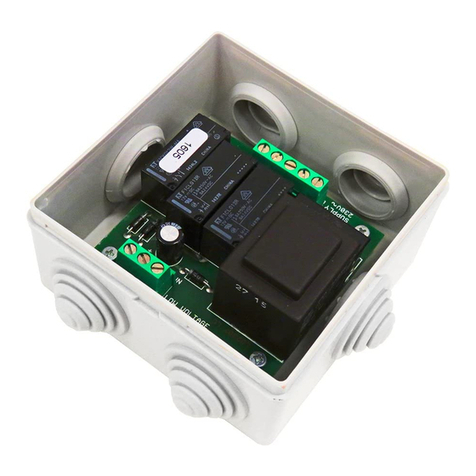
Seav
Seav LG 2020 New User manual
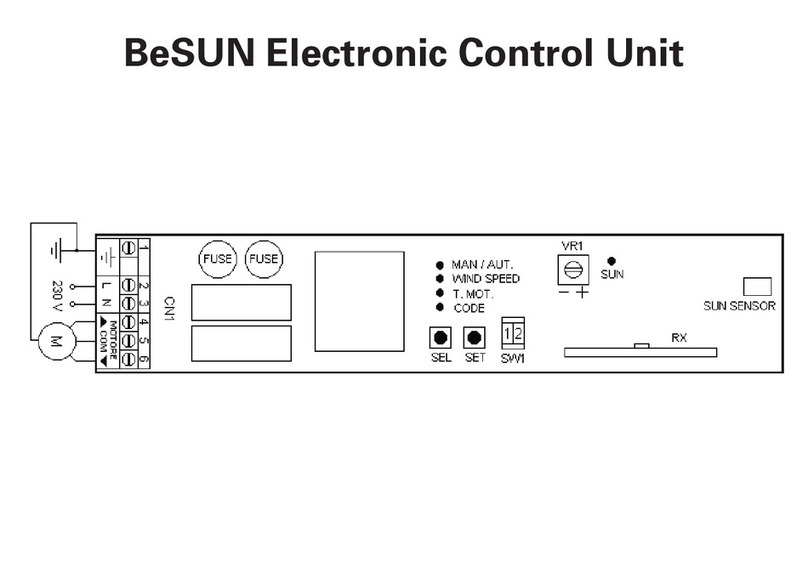
Seav
Seav BeSUN 433 User manual

Seav
Seav LR 2215 Series User manual

Seav
Seav LRX 2329 User manual
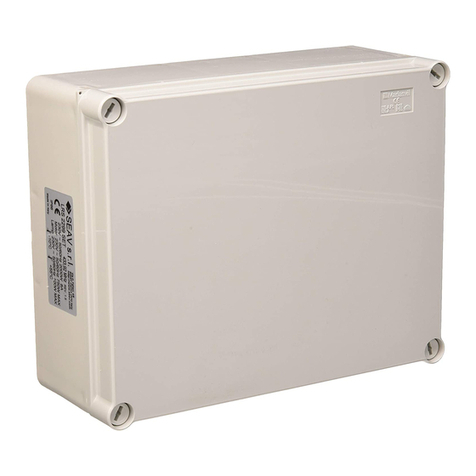
Seav
Seav LRX 2299 NEW User manual
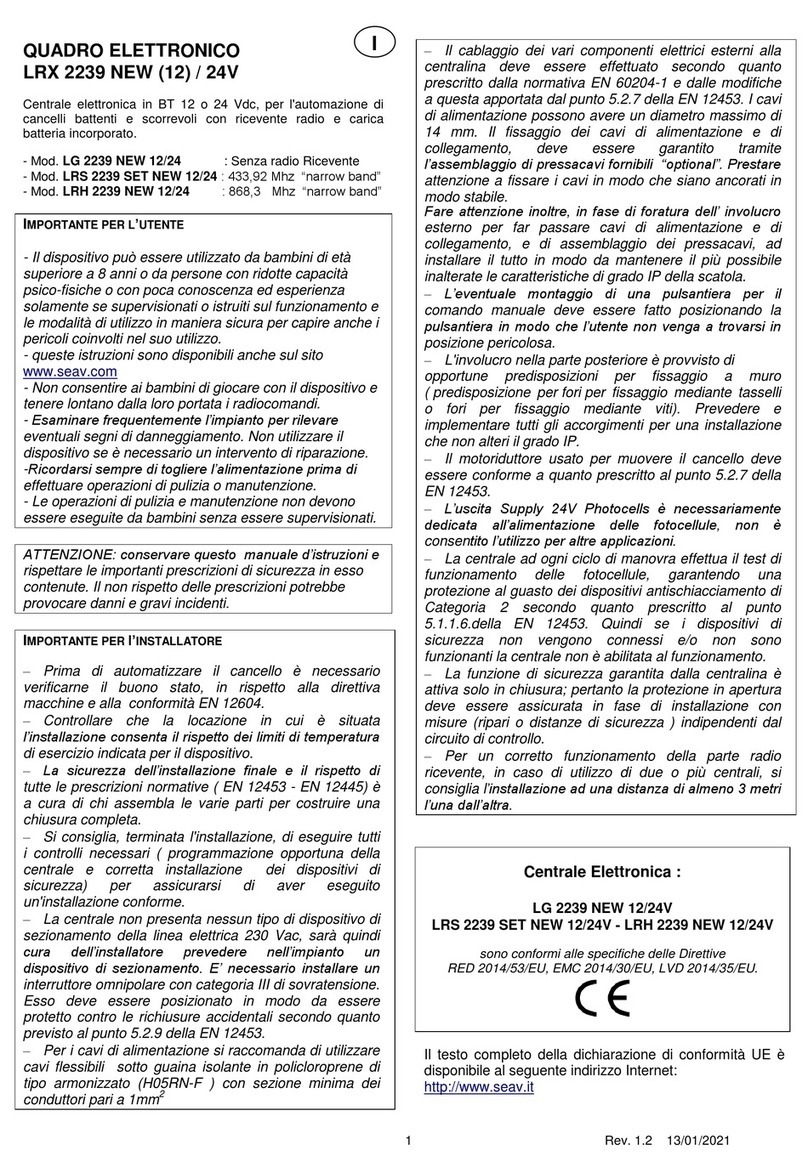
Seav
Seav LRX 2239 NEW 12V User manual
Popular Control Unit manuals by other brands

TA Hydronics
TA Hydronics STAF-SG Series manual
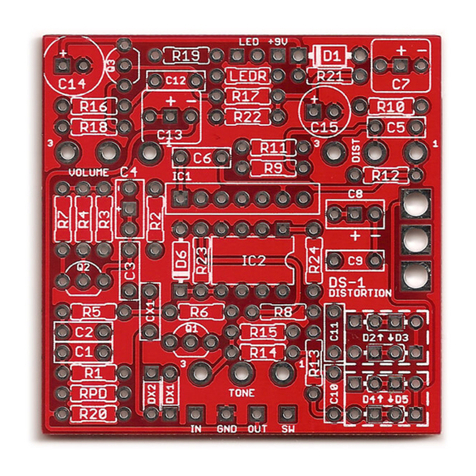
Aion Electronics
Aion Electronics Comet Distortion manual
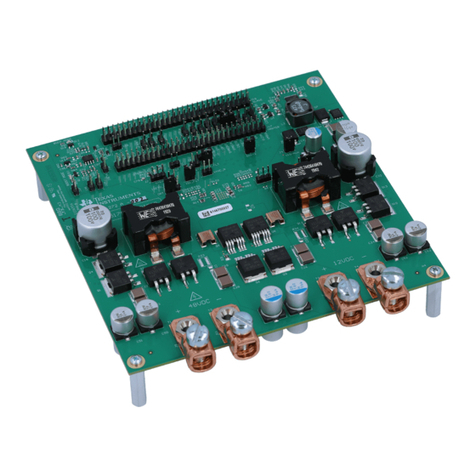
Texas Instruments
Texas Instruments LM5170-Q1 EVM user guide
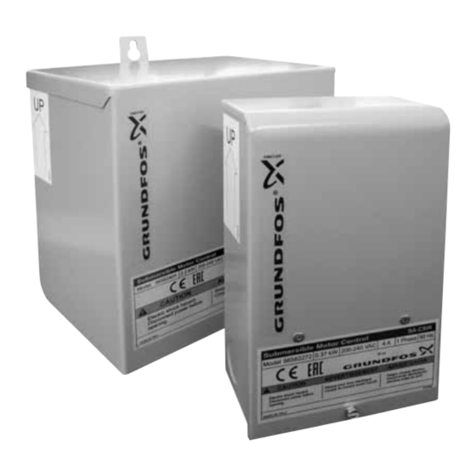
Crundfos
Crundfos SA-CSIR Nstallation and operating instructions
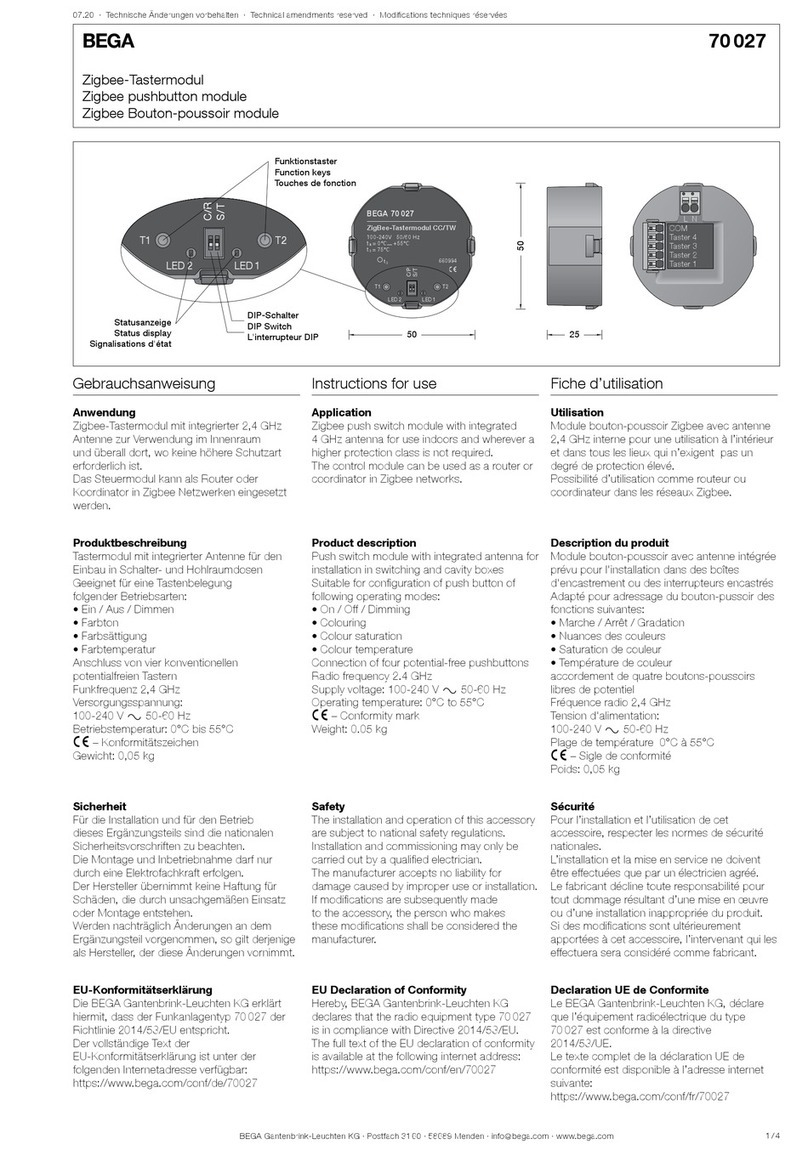
BEGA
BEGA 70 027 Instructions for use
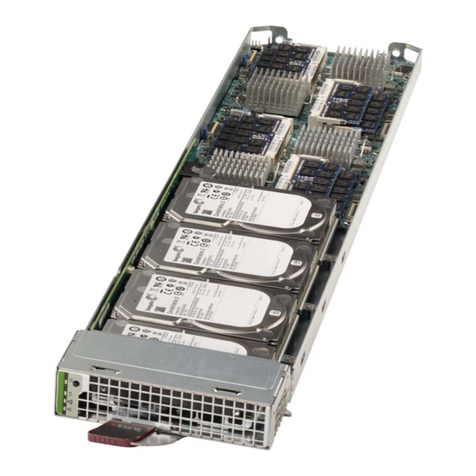
Supermicro
Supermicro MBI-6418A-T5H user manual
